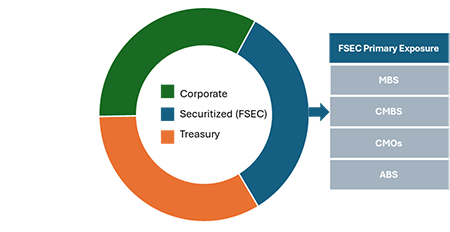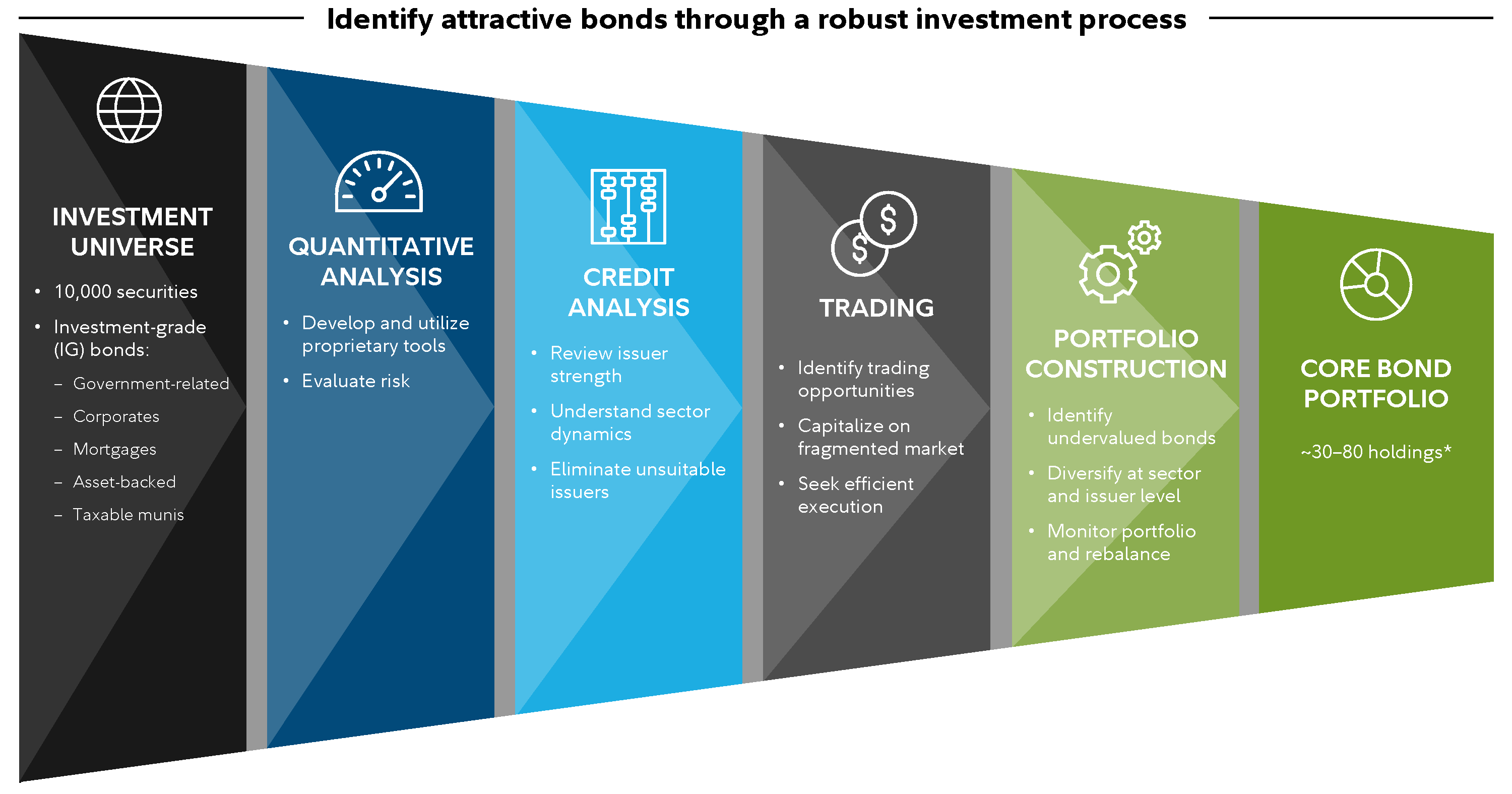Fidelity® Core Bond StrategyA separately managed account providing investment-grade bond exposure through a diversified mix of individual bonds and a Fidelity exchange-traded fund (ETF), which seeks to deliver interest income while balancing risk and return. This actively managed strategy looks to maintain an average target duration1 of 3 to 5 years. |
Investment strategy: Seeks to deliver interest income, while limiting risk to principal over a full market cycle.
Types of investments: Primarily A- or higher investment-grade2 taxable bonds at time of purchase and a Fidelity exchange-traded fund (ETF) providing exposure to securitized bonds.
Investment minimum: $350,0003
Gross annual advisory fee: 0.35% – 0.40%4 (varies based on total assets invested)
- A diversified mix of individual investment-grade bonds—including government-issued, corporate, and taxable municipal securities—complemented by a Fidelity ETF that offers exposure to securitized bonds
- Managed by an investment team leveraging Fidelity's extensive fixed income resources and research capabilities.
- Seeks to provide a balance between income potential and risk.
- Considers both income and price appreciation as potential sources of return and seeks bonds with a favorable risk/reward trade-off.
Seeks income from high-quality bonds
- Target average rating5: Primarily A- or higher
- Minimum credit quality: Bonds rated BBB- or better at purchase.
- Average target duration: 3 to 5 years
- Maturities: Bonds generally maturing within 20 years

Diversified exposure
The Strategy invests in a diverse mix of investment-grade bonds across a range of sectors and varying maturities.
A decline in one sector could hopefully be offset by a gain in another, which may help smooth out portfolio volatility.

Investing in a specialized segment of the bond market
To gain exposure to the securitized segment of the bond market—an area traditionally dominated by institutional investors—the Strategy utilizes the Fidelity Investment Grade Securitized ETF (FSEC). This ETF provides exposure to a professionally managed portfolio of securitized fixed income instruments, including mortgage-backed securities (MBS), commercial mortgage-backed securities (CMBS), collateralized mortgage obligations (CMOs), and asset-backed securities (ABS).
The Strategy will typically maintain approximately one-third6 of the portfolio in FSEC, though allocations may vary over time based on market conditions and portfolio positioning. The ETF structure offers daily liquidity, transparency, and operational efficiency, making it a flexible and effective way to access this specialized sector.
Fidelity Core Bond SMA

For illustrative purposes only.
The allocations shown are not indicative of the actual weights within the portfolio.
Benefits of using Fidelity Core Bond SMA FSEC within the Strategy
- Broader income potential: Securitized bonds may offer higher yields than government bonds.
- Greater access for individual investors: Many securitized bonds are typically available only to large institutions or require high minimum investments. FSEC offers a way for individual investors to access this segment of the market without those traditional barriers.
- Expanded diversification: Securitized bonds are backed by assets like home mortgages and consumer loans—areas not typically represented in government or corporate bonds. Including them in a portfolio through FSEC can help diversify sources of return and risk.
Strives to balance income and price appreciation vs. risk
Fidelity Core Bond Strategy considers both income and price appreciation as potential sources of return and seeks bonds with a favorable risk/reward trade-off. Using a research-based approach, the investment management team strives to avoid bonds that will not compensate bond holders for their investment risk.
To also help manage risk, the strategy will seek to maintain an average duration similar to that of the Bloomberg Intermediate U.S. Aggregate Bond Index.7
In general, portfolios with shorter durations are less sensitive to changes in interest rates than portfolios with longer durations.

- Fully independent and proprietary research
- Leverage research across fixed income, high yield, and equity
- Analyze opportunities and risks using proprietary models and tools

- Invest in a broad range of investment-grade bonds
- Invest in a Fidelity ETF (FSEC) providing liquidity and diversified exposure to securitized bonds
- Exposure to BBB rated bonds limited to 20% or less at time of purchase
- Seek to provide an experience consistent with client expectations

- Employ a total return approach—consider both yield and risk
- Emphasize opportunities that have price upside potential
- Strive to avoid bonds whose yields may not offset their risks
Tapping Fidelity's Fixed Income expertise
Strategic Advisers LLC (Strategic Advisers), has engaged Fidelity Management & Research Company LLC (FMR), a registered investment adviser and a Fidelity Investments company, to provide the day-to-day discretionary portfolio management of Fidelity Core Bond Strategy accounts, including investment selection and trade execution, subject to Strategic Advisers’ oversight.
FMR brings investors a rich history of managing fixed income investments for over 50 years.
Using proprietary research, models, and tools, FMR can analyze thousands of securities across the investmentgrade taxable bond universe.
This capability allows them to:
- Build a diversified taxable bond strategy
- Support income generation
- Balance risk and return potential
- Help keep your account aligned with your preferences

† Fidelity Investments, as of 12/31/24. Data is unaudited. Investment team members include portfolio managers, traders, and research analysts and associates.
Fidelity Fixed Income Division
- $2.3+ Trillion Assets Under Management*
- 50+ years of experience
- 200+ team members†
50+ active portfolio managers
- Lead the investment team
- Uses deep market experience to manage
- Ensure each strategy is managed to its specific objective
- Select appropriate bonds for individual client portfolios
130+ research and credit analysts
- Identify attractive bonds and monitor existing holdings
- Conduct up front and ongoing credit quality analyses
- Assess individual issuers' value and outlooks
- Employ specialized tools and models
30+ professional traders
- Seek to improve returns by using proprietary technology and timely market knowledge
- Pursue flawless trade execution
Fidelity's Fixed Income division believes investment success is a function of teamwork—involving portfolio managers, quantitative analysts, credit analysts and traders. Their investment team will actively manage your account, putting their knowledge, experience, and resources to work as they seek to uncover opportunities in all types of markets.

Why will my account hold a Fidelity exchange-traded fund?
The Fidelity Investment Grade Securitized ETF (FSEC) offers access to a professionally managed portfolio of securitized fixed income instruments—including mortgage-backed securities (MBS), commercial mortgage-backed securities (CMBS), and assetbacked securities (ABS).
These types of securities can provide distinct risk and return characteristics compared to traditional corporate or government bonds. By incorporating FSEC, your portfolio gains exposure to a segment of the bond market that is typically less accessible to individual investors. Additionally, the ETF structure provides benefits such as daily liquidity and operational efficiency.
This addition supports the ongoing effort to enhance diversification within your Core Bond SMA, helping to broaden exposure across different fixed income sectors.
How we select bonds for your account
The investment team looks at many factors when assessing risk for each proposed bond, including but not limited to, issuer specific credit risk, sector risk, interest rate risk, and liquidity risk.
The team assigns a proprietary credit rating to each bond they purchase, which is independent of the rating agencies. The team focuses on selecting investment-grade bonds that offer strong relative value in an effort to generate income while seeking to limit risk to the money invested.
Each account is diversified across a variety of sectors and maturities to help ensure it is not concentrated in any one area, can better handle changes in interest rates, and potentially helps reduce overall risk to principal over the long term.
Diversification does not ensure a profit or guarantee against loss.
Do we hold bonds to maturity?
Bonds can be sold prior to maturity when market opportunities or portfolio needs arise.
While the investment team manages the portfolio with a focus on maintaining low turnover, trades may be made to enhance return potential and manage risk. These decisions are typically driven by factors such as changes in credit quality, relative value opportunities through security selection, strategic yield curve positioning, or evolving cash flow needs.

